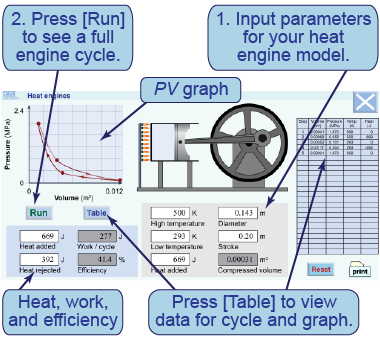| | Essential questions | | How does a heat engine work? | |
|
A heat engine converts thermal energy (heat) into mechanical energy (work). Most heat engines use a gas as a working fluid. The gas does work by expanding. In this investigation, a simulated heat engine illustrates the PV diagram and models the efficiency of a heat engine at different temperatures. 
|
Understanding the model
This simulation allows you to set the working temperatures and dimensions of an ideal heat engine. Pressing [Run] will cause the engine to operate its cycle with the parameters you have set and plot the corresponding PV diagram. The simulation calculates the ideal efficiency and output work by assuming that the engine operates on air. The engine will allow you to make the cylinder as large as 0.5 m in either dimension. 
|
Construct your model of a Carnot heat engine

- Set the initial operating temperatures to 550 and 1,293 K. Set the piston diameter to 20 cm (0.2 m) and the stroke to 20 cm (0.2 m).
- Press [Run] to see a cycle. Use the data table to look at the pressure and volume data.
- Alternately, you may set the heat input and the simulation will calculate the maximum temperature. Set a heat input of 1,000 J and see what happens.
- What is the operating efficiency at the parameters above?
- What is the highest pressure reached? What is the lowest pressure?
- What could you do to improve the efficiency of the engine? Propose two possible changes and then design an experiment to test each of your changes. Your experiments should have procedures for how you will change variables, and which variables you will change, to determine the effect of your changes.
- What conclusions do you draw from your experiments?
- What is the maximum possible theoretical efficiency given the limit of 293 K as the lowest operating temperature and 6,000 K as the highest operating temperature? What might happen to the piston at this high temperature?

|
|
In this interactive simulation of a Carnot heat engine, you can adjust the dimensions of the piston, the high and low temperatures, and the input and output heat. If you stretch the parameters too much, the pressure inside the piston may be too great. Press [Run] to watch the heat engine animation and see the corresponding curves on the PV diagram. Press [Table] to inspect the pressure, volume, temperature, and heat flow for each part of the Carnot cycle.
|
| |
|

